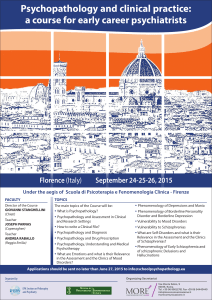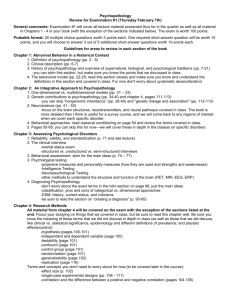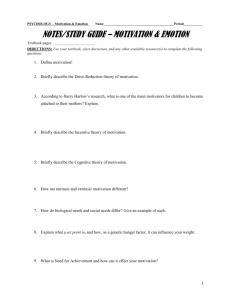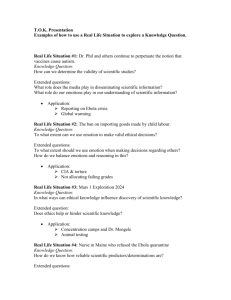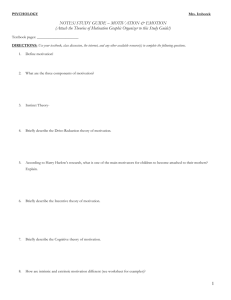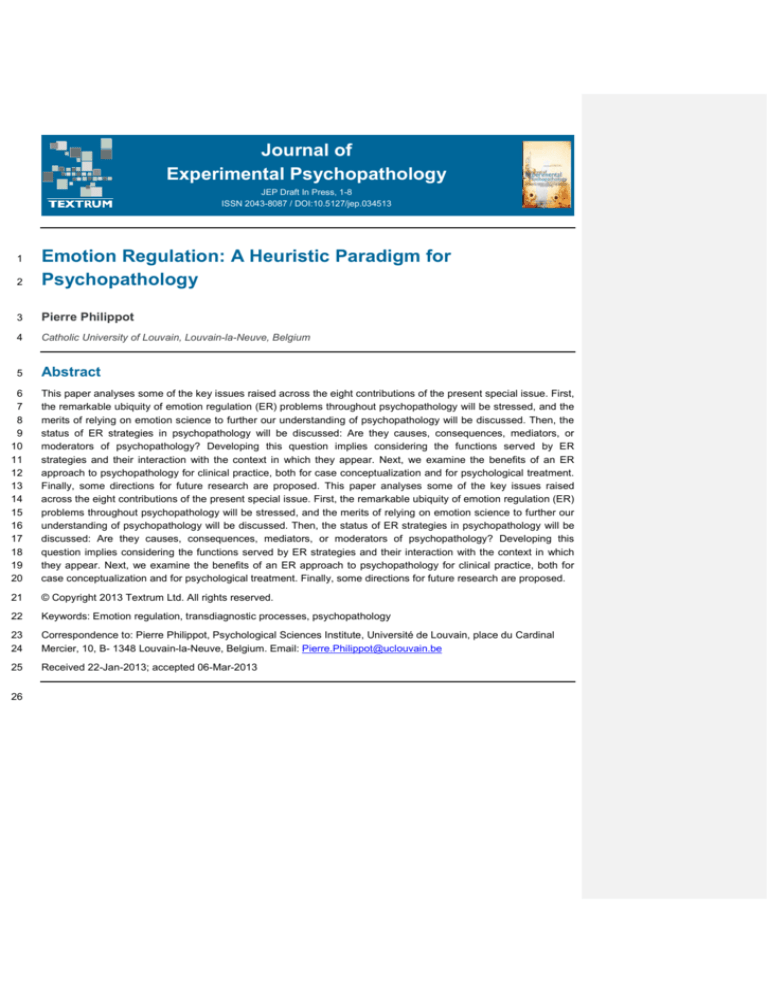
Journal of
Experimental Psychopathology
JEP Draft In Press, 1-8
ISSN 2043-8087 / DOI:10.5127/jep.034513
2
Emotion Regulation: A Heuristic Paradigm for
Psychopathology
3
Pierre Philippot
4
Catholic University of Louvain, Louvain-la-Neuve, Belgium
5
Abstract
1
6
7
8
9
10
11
12
13
14
15
16
17
18
19
20
This paper analyses some of the key issues raised across the eight contributions of the present special issue. First,
the remarkable ubiquity of emotion regulation (ER) problems throughout psychopathology will be stressed, and the
merits of relying on emotion science to further our understanding of psychopathology will be discussed. Then, the
status of ER strategies in psychopathology will be discussed: Are they causes, consequences, mediators, or
moderators of psychopathology? Developing this question implies considering the functions served by ER
strategies and their interaction with the context in which they appear. Next, we examine the benefits of an ER
approach to psychopathology for clinical practice, both for case conceptualization and for psychological treatment.
Finally, some directions for future research are proposed. This paper analyses some of the key issues raised
across the eight contributions of the present special issue. First, the remarkable ubiquity of emotion regulation (ER)
problems throughout psychopathology will be stressed, and the merits of relying on emotion science to further our
understanding of psychopathology will be discussed. Then, the status of ER strategies in psychopathology will be
discussed: Are they causes, consequences, mediators, or moderators of psychopathology? Developing this
question implies considering the functions served by ER strategies and their interaction with the context in which
they appear. Next, we examine the benefits of an ER approach to psychopathology for clinical practice, both for
case conceptualization and for psychological treatment. Finally, some directions for future research are proposed.
21
© Copyright 2013 Textrum Ltd. All rights reserved.
22
Keywords: Emotion regulation, transdiagnostic processes, psychopathology
23
24
Correspondence to: Pierre Philippot, Psychological Sciences Institute, Université de Louvain, place du Cardinal
Mercier, 10, B- 1348 Louvain-la-Neuve, Belgium. Email: Pierre.Philippot@uclouvain.be
25
Received 22-Jan-2013; accepted 06-Mar-2013
26
Journal of Experimental Psychopathology, Draft In Press, 1-8
2
27
Table of Contents
28
29
30
31
32
33
34
Introduction
The Ubiquity of Emotion Regulation in Psychopathology
The Status of Emotion Regulation Strategies in Psychopathology
Plead For a Functional Perspective on Emotion Regulation
The Benefits of Emotion Regulation Science for Clinical Intervention
Conclusion and Future Directions
References
35
Introduction
36
37
38
39
40
41
42
43
44
45
For decades emotion has been neglected in clinical psychology. Early behaviorism viewed emotion as too
introspective to be the object of a truly scientific inquiry (Watson, 1914); psychoanalysis considered emotion as the
symptomatic consequence of inner conflicts, a perspective shared by cognitive therapists (Beck, 1976).
Fortunately, this state of affair began to change at the end of the eighties, with the contribution of leading clinicians
who attributed a central role to emotion in their etiological model of psychopathology (e.g. Barlow, 1984) or in their
clinical intervention protocols (e.g. Greenberg, 2002). At about the same time, cognitive psychopathology started to
develop, initially importing cognitive psychology models and paradigms in the field of psychopathology, which, in
actuality, resulted in examining how emotional information was processed by individuals afflicted by given
psychopathological disorder. Yet, it is only recently that the theoretical models constructed by emotion researchers
are being used in psychopathology.
46
47
48
49
50
51
52
53
54
55
The present special issue is thus extremely timely. Focusing on emotion regulation (ER), it addresses some of the
most fundamental questions to which clinical psychologists are confronted: how do affective disturbances appear
and how are they maintained, despite the will of the sufferers to escape them. In this concluding commentary, I will
develop some of the issues raised across the eight contributions. First, I will comment on the remarkable ubiquity of
ER problems throughout psychopathology, and of the merits of relying on emotion science to analyze this question.
Then, I will question the status of ER strategies in psychopathology: Are they causes, consequences, mediators, or
moderators of psychopathology? Developing this question will lead us to consider the functions served by ER
strategies and their interaction with the context in which they appear. Next, I will concretize the benefits of an ER
approach to psychopathology for clinical practice, both for case conceptualization and for psychological treatment.
Finally, a conclusion will propose some directions for future research.
56
The Ubiquity of Emotion Regulation in Psychopathology
57
58
59
60
61
62
63
64
65
In 2001, Kring has shown that many of the DSM criteria for its axis I disorders were referring to emotion. Jazaieri,
Urry and Gross (this issue) extended this seminal work in a detailed and systematic analysis of the DSM IV criteria
for all disorders. They show that more than 40% of DSM disorders mention affective disturbance in their required
criteria. However, only 21% clearly refer to problems in emotion regulation. Still, this observation is remarkable for
several reasons. Indeed, the mention of emotional manifestations in diagnostic criteria was a priori unlikely given
the long disregard of psychopathology and clinical psychology for emotion and for the concepts developed by
emotion science. Further, the DSM criteria focus on observable symptoms, while most ER processes are
intrapsychic and not directly observable. Despite this a priori unfavorable ground, Jazaieri et al.’s analysis clearly
indicates that ER issues are at stake in many psychopathological disorders.
66
67
68
69
70
71
72
The ubiquity of ER in psychopathology is also evidenced in the consideration of positive ER by Hechtman, Raila,
Chiao and Gruber (this issue). These authors transcended the dichotomy between allegedly “positive” and
“negative” emotions and the simplistic notion that ER would consist in down-regulating “negative” emotions and in
up-regulating “positive” ones. They show that deficits in regulating positive emotion might result in
psychopathological problems, e.g. in alcohol abuse or depression. Indeed, difficulties might also result from the
inability to down-regulate positive emotions, such as in bipolar disorder, or to expression negative emotions, such
as the inhibition of appropriate anger in social anxiety.
Comment [CE1]: Please add to ref
list.
Comment [CE2]: Please add to ref
list.
Journal of Experimental Psychopathology, Draft In Press, 1-8
3
73
74
75
76
77
78
79
Hechtman et al. (this issue) also bring to light two important facets of the ubiquity of ER. First, they demonstrate
that ER in its relation with psychopathology is an issue in many, if not in all, cultures. Culture shape the
understanding of emotion: They note, for instance, that, in contrast to the North-American culture, Asian cultures
consider that “positive” emotions are not unambiguously positive and, conversely, that “negative” emotions are not
necessarily all that negative. Cultures have consequently different prescriptions regarding appropriate ways to
regulate emotion, which might result in different prevalence of psychopathological disturbances, as documented by
Hechtman et al.
80
81
82
83
84
85
86
87
88
A second facet of ER ubiquity is highlighted by Hechman’s et al. (this issue) detailed and documented multi-level
and trans-disciplinary analysis, establishing a new discipline: cultural neurosciences. Considering cultural variation
in psychopathology, they cover from the molecular level of ER, examining the implication of specific gene alleles
such as the 5-HTTLPR or the DRD4, to brain activity, behavior, to finally reach the molar level of culture. At each
level, they report cultural variations, which are then related to similar variations at other levels. In this complex
analysis, ER has proven to be a heuristic concept for establishing links across levels and for accounting for cultural
variations. Conversely, such multilevel analysis is remarkably informative in establishing the determinants of the
many facets of ER. In this line, such an approach provides insight for fixing the possibilities and limits of
psychological intervention on ER.
89
The Status of Emotion Regulation Strategies in Psychopathology
90
91
92
93
94
95
96
97
The very fact that some ER strategies are quoted as diagnostic criteria or symptoms in the DSM IV (Jazaieri et al.,
this issue) is raising the question of their status in etiological models. We have to disentangle what, in ER, is a
psychopathological process from what is a psychopathological symptom, i.e. the consequence of the process. In
other words, the question should be raised of whether ER disturbances or specificities are an “input” or an “output”
of the disorder. Providing that an ER strategy is possibly an input of a psychopathological disturbance, one should
wonder whether this ER strategy is a direct cause of the disturbance, or whether it mediates or moderates the
causal effect of another process, or whether, it is merely a consequence or symptom of the disturbance, without
any causal implication in the psychopathological disturbance.
98
99
100
101
102
103
104
105
106
107
108
This issue is central to many contributions of the present issue. For instance, three papers have focused on worry
or rumination as an a priori maladaptive ER strategy. Cooper, Miranda and Mennin (this issue) defend the notion
that individuals with generalized anxiety disorder (GAD), primed with anxiety, and who latter tend to avoid emotion,
subsequently display greater depth of worry. These findings show important functional links between emotional
avoidance and worry, congruently with the model of Borkovec, Alcain and Behar (2004) for which ruminative
worrying is a form of emotional avoidance that plays a major role in the maintenance of anxiety in GAD. In this
conceptualization, worry mediates the effects of anxiety and uncertainty on GAD symptoms. However, the present
data of Cooper et al. suggest that this might not be the case for all people with GAD, as this effect was observed
only in those who attempted to avoid the unpleasant emotion induced. This implies that alternative mediating paths
might exist. Additional research is needed to replicate these findings and, providing they are, to identify the
moderator.
109
110
111
112
113
114
115
116
117
118
119
120
121
LeMoult, Ardite, D’Avanzato and Joorman (this issue) studied rumination in a dysphoric sample, after the induction
of a social stress. They observed that the more people ruminated after the social stressor, the less they recovered
from the sadness it had induced. This clearly indicates that rumination directly impacts on the maintenance of low
mood, following a stressor. Interestingly, these authors observed that individuals suffering from high dysphoria and
who also present difficulties in disengaging their attention from emotional material, are also the ones who
manifested the higher level of rumination following the stressor. It nicely shows how the use of a given ER strategy
might be constraint by cognitive impairment or depletion of resources. Interestingly, LeMoult and collaborators
distinguished between trait and state rumination, observing the above mentioned effects only for state rumination.
This reinforces their interpretation that it is the actual use of that specific ER strategy, rumination, that yields the
unfortunate emotional disturbance consequences, and not a personality trait that could possibly act via a third
variable. In conclusion, Lemoult et al. (this issue) bring support to the notion that rumination is a causal determinant
of the maintenance of low mood in dysphoric individuals, and that these individuals are more likely to rely on this
ER strategy if their attentional disengagement capacities are limited.
Journal of Experimental Psychopathology, Draft In Press, 1-8
4
122
123
124
125
126
127
128
Finally, Svaldi and colleagues (this issue) directly manipulated rumination (while the two previously mentioned
studies observed it). Following an induction of body dissatisfaction, obese women were invited to either ruminate
on, or accept their present thoughts and feelings. Svaldi et al. observed that mood and body satisfaction returned
to baseline (measured before the body dissatisfaction induction) in those who practiced acceptance of their
thoughts and feelings. In contrast, those who were instructed to ruminate maintained lower mood and more
distress about their body. The experimental design of the study brings strong support to notion that rumination is a
causal determinant of distress and low mood after the induction of a threat to the self.
129
130
131
132
133
134
Taken as a whole, these three contributions document that the rumination phenomena observed in
psychopathology are not merely symptoms of psychological disturbances. Rather, they suggest, at least the two
latter ones, that some ER strategies, such as rumination, might play a major role in the onset or in the maintenance
of psychopathological symptoms. The exact status of rumination in Cooper et al’s (this issue) study, is still not fully
established; It is certainly not to be considered as a consequence or output, but its status as moderator or mediator
of GAD symptoms needs further research to be established.
135
136
137
138
139
140
141
142
143
144
145
146
147
Two other contributions to the present issue focused on a diagnosis, borderline personality disorder (BPD),
attempting to evidence its characteristics in terms of ER. Chapman, Dixon-Gordon and Walters (this issue) defend
the original and provoking hypothesis, that BPD is not a consequence of the inability to regulate emotion, as
commonly believed, but rather that it results from a tendency to over-regulate emotion. People suffering from BPD
would devote great effort and much resources to down regulate their emotions, depleting their resources and
consequently lacking the necessary resources for functional behavior. In their study, they observed that, compared
to healthy controls, BPD sufferers reported more intense emotions of fear nervousness and hostility following a fear
induction, and greater use of some ER strategies like distraction, reappraisal or emotion suppression (but less of
emotional acceptance). This finding is partly counter-intuitive, given that reappraisal is often a priori considered as
an adaptive ER strategy. Chapman and collaborators also observed that the lack of emotional acceptance in BPD
sufferers, when confronted with a stressor, was related to heightened hostility in response to the stressor. Overall
these observations suggest that some ER strategies might mediate the effect of a stressor on psychopathological
disturbances, while other ER strategies (e.g. acceptance) might act as a moderator.
148
149
150
151
152
153
154
155
156
157
158
159
Evans, Howard, Dudas, Denman and Dunn (in press) also induced negative emotion in people with varying
severity of BPD features. In different conditions, they observed either the spontaneous, or the instructed use of two
ER strategies: suppression and acceptance. In contrast to Chapman et al.’s study, Evan et al. did not observe
greater emotional responses to the mood induction. However, those with more BPD features manifested a slower
emotional recovery post induction. The partial divergence between the two studies regarding the observed
emotional responses to the stressor is difficult to explain. They both used film excerpts to induce emotion, although
the excerpt used by Chapman et al. (scene of a chase in the basement from “the silence of the lambs”) might have
been more arousing and fear-inducing than the ones used by Evans et al. (scenes of emotional and physical
abuses in dysfunctional couples). Still, the theme of the latter excerpts might have been more relevant to BPD
concern than the theme of the former. Another significant difference is that Evans et al. considered the whole
continuum of borderline trait features in the general population, while Chapman et al. contrasted, in a student
population, healthy controls to students scoring within the clinical range of BPD.
160
161
162
163
164
Still, congruent with the observations of Chapman et al., Evans et al. observed that people with elevated BPD
features were not manifesting difficulties in using ER strategies, contrary to common belief. They also report a
positive correlation between the use of avoidant strategies and BPD features, but no relation with acceptance.
Unexpectedly, in this study, there was no evidence that acceptance was more effective in regulating emotion than
suppression.
165
166
167
168
169
In sum, taken together, the studies of Chapman et al. and of Evan et al. concur in seriously challenging the
commonly accepted notion that BPD is characterized by a deficit in ER. Rather, they suggest that BPD sufferers
are perfectly able to use ER strategies and that their problem might actually be that they over-use them or miss-use
them (this notion will be developed in the next section). In other words, they would concentrate all their resources
on regulating emotion, and might find themselves depleted when it comes to planning and enacting functional
Journal of Experimental Psychopathology, Draft In Press, 1-8
5
170
171
behavior. Still, more research is needed to further examine whether BPD sufferers over-respond to emotion
elicitation, and whether they are really effective in their use of ER strategies.
172
173
174
175
176
177
178
179
The question of the status of ER in psychopathology was also investigated from a different angle by Tull, Kiel,
McDermott and Gratz (this issue). They examined in cocaine dependent patients with or without PTSD whether
exposure to trauma reminders increases craving. They observed that indeed, when male participants with a PTSD
experienced self-conscious emotions (shame and guilt) in response to a trauma reminder, their craving for cocaine
increased. This suggests that trauma memories do not have a direct impact on cocaine craving. Rather, a possible
interpretation of the present findings, is that this impact is moderated by how the trauma situation is appraised. If,
and only if, this appraisal implies a threat to the self and a personal responsibility, resulting in self-conscious
emotions, then craving will be potentiated.
180
181
182
183
184
185
186
187
188
189
190
To conclude the many and diverse contributions to the present issue all considered that ER is not just an
epiphenomenon, or the symptomatic expression of psychopathological disorders. Rather, they all attribute to ER a
role in the path leading to psychopathology, be it the one of direct cause, of moderator, or of mediator. Further, this
ER based approach is yielding new perspectives on psychopathology, forcing us to reconsidered formerly well
accepted notions, such as the one of an alleged deficit in ER in BPD. Conversely, some results are also intriguing
as they question previous conceptions of ER. For instance, ER strategies, generally considered as adaptive such
as reappraisal, seem to be linked to the maintenance of some psychopathological disturbance. Further, the same
strategies seem not to be more efficacious than alleged adaptive strategies, such as acceptance, at least in certain
settings or populations. To overcome this puzzle, we propose that ER strategies should not be considered in
isolation, but rather in the perspective of the functions they serve in the context in which they appear. This notion is
developed in the next section.
191
Plead For a Functional Perspective on Emotion Regulation
192
193
194
195
196
197
198
In studying the relation between ER and psychopathology, it is tempting to attempt to identify the ER strategies that
would be adaptive and the one that would be maladaptive. However, the findings of several studies in the present
special issue question this approach. Indeed, some have observed that certain psychopathological disorders are
characterized by the greater use of a priori adaptive ER strategies, such as the over-use of reappraisal in BPD, as
reported by Chapman et al. (this issue). Others (e.g. Evans et al. this issue) have failed to observe differences in
effectiveness between strategies that are a priori considered as adaptive (e.g. acceptance) or maladaptive (e.g.
suppression).
199
200
201
202
203
204
205
206
207
208
209
210
211
212
These observations militate for taking into consideration the function of given ER strategies. Indeed, an ER strategy
might not be in itself and in all circumstances adaptive or maladaptive. One has to consider its function, i.e. the
goal pursued, or the instrumental use of the ER strategy. This implies taking into consideration the context in which
the ER strategy is used. For instance, cognitive reappraisal is unlikely to be adaptive if it entails disregarding
important actual meanings in the emotional situation. These meanings might be unpleasant, and consequently
they might trigger allegedly negative emotions, but they have to be taken into consideration in order to adapt to the
reality of the situation. This might be the case, for example, in a situation in which a significant harm is willfully
inflicted by a third party. Disregarding this specific (and realistic) appraisal of the situation, as it might be observed
in avoidant or in socially anxious individuals, is likely to result in not stopping the abuse or in more abuse in the
future. Conversely, suppression, an allegedly a priori maladaptive ER strategy, might be adaptive in urgency
situation of dire strait in which action has to be performed without interference by emotional feelings that might
trigger dysfunctional action tendencies. For instance, suppression of fear and disgust might be necessary to
provide first assistance to severely wounded casualties of a car accident, while the spontaneous action tendency
triggered by emotion would be to flight away.
213
214
215
216
217
Hence, I defend the notion that any given ER strategy cannot be considered a priori as adaptive or not. A taxonomy
of the good versus bad ER strategies is meaningless. ER strategies have always to be understood in the light of
the function they serve. Different ER strategies will be better suited according to the type of emotion to be
regulated, to the context in which the emotion unfolds, and to the goal pursued by the individual. Here, like it is
often the case in psychopathology, flexibility is the golden key for success (Bonanno, Papa, Lalande, Westphal, &
Journal of Experimental Psychopathology, Draft In Press, 1-8
6
218
219
220
221
222
Coifman, 2004). Psychological health is likely to be best preserved for individuals who are able to vary the ER
strategies they use according to the context and the goal they pursue. This notion might explain why individuals
suffering from GAD are afflicted by emotional disturbances, while they seem to be perfectly able to use a variety of
ER strategies. The fact is that they might not apply them appropriately to the context or to their goals, or that they
might overuse them.
223
224
225
226
227
228
229
230
231
232
233
234
235
236
237
In his study of rumination, Watkins (2011) provides a nice illustration of the flexible approach to ER. He
distinguished between two types of rumination (Watkins, 2008), one centered on the concrete and present aspects
of one’s state and experience (“how am I feeling now; what is going on now”), labeled concrete experiential
rumination, and the other on the possible causes and consequences of concrete one’s state and experience (“why
am I feeling like that now; what will happen if I continue to feel this way”), labeled abstract analytic rumination.
Studying depression, it appeared that abstract analytic rumination is generally depleting mood and generating other
adverse consequences, while concrete experiential rumination has the opposite effect (Watkins, 2004). The former
type of rumination was thus qualified as maladaptive and the latter as adaptive. However, further investigations
revealed that the state of affair is not that Manichean. Indeed, it appeared that abstract analytic thinking is effective
when one has to resolve problems involving high order goals and meaning (e.g., having to decide on whether reorienting one’s professional career), but ineffective when regulating low level goals, such as when regulating day to
day moods, or being confronted to a daily hassle. Concrete experiential thinking holds exactly the opposite
characteristics and is useful when dealing with concrete, present problems. Hence, Watkins (2011) concludes that
psychological adaptation is best achieved by a flexible use of either type of rumination mode, according to the
nature (level) of the goal at stake in each given situation.
238
The Benefits of Emotion Regulation Science for Clinical Intervention
239
240
241
242
243
244
245
Although recent, the application of ER science to psychopathology is rich in practical implications for clinical
practice, both for case formulation and for intervention. Regarding case formulation, emotion science in general
and ER in particular, provide many useful and empirically validated concepts for finely describing
psychopathological phenomena. This is well illustrated in the systematic analysis of the DSM criteria by Jazaieri et
al. (this issue) who also stress that the description of psychopathological phenomena would gain in precision and
relevance if the taxonomies of ER strategies evidenced by emotion science would be used to define
psychopathological disorders.
246
247
248
249
250
251
252
253
254
255
256
257
258
259
Pushing this reasoning a step further, some have even contended that emotion and its regulation could serve as a
funding paradigm for psychopathology (e.g. Barlow, 2002). Emotion indeed bares many characteristics that make it
an interesting model for psychopathology. First, it relates to many, if not all, facets of human behavior: Emotion
includes feelings, physiological responses, cognitive changes, action tendencies, social interactions, etc.. Second,
emotion recruits both conscious and non-conscious, automatic and voluntary, processes. Further, emotion science
provides models articulating these phenomena and accounting for their inter-relationships (e.g. Power & Dalgleish,
2008). This body of research thus offers important insights on how automatic affective responses—the hallmark of
psychopathology—might be modulated by voluntary behavior. In other words, it provides the theoretical basis to
design psychological interventions, acting on voluntary behavior, that could modulate dysfunctional automatic
affective responses. Third, emotion is intimately related to the values and goals pursued by the individuals (Carver
& Scheier, 1990), and hence to their identity. These key features of emotion make it valuable as a reference model
(i.e. a paradigm) for case formulation in psychopathology. Not only does it add precision and fineness in the
definition of the relevant ER processes, but also, an ER-based approach to case formulation significantly
contributes to moving from a descriptive approach to a theory-based, explanatory one (Barlow, 2004).
260
261
262
263
264
265
In this line, many authors of this special issue referred to a transdiagnostic approach in case formulation (Harvey,
Watkins, Mansell & Shafran, 2004). This new look in psychopathology operates a Copernican revolution: Rather
than attempting to decipher the processes and features that characterize a given psychopathological diagnosis
considered as essential entities, it aims at identifying the psychological processes that bare psychopathological
consequences across diagnoses. In this perspective, the diagnosis is less a central concern for psychopathology.
The main intention of the transdiagnostic approach is to relate psychological processes to psychopathological
Journal of Experimental Psychopathology, Draft In Press, 1-8
7
266
267
symptoms or profiles of symptoms. As developed in the preceding paragraphs, most of these transdiagnostic
processes are related to ER, making this domain of science an important reference in psychopathology.
268
269
270
271
272
273
274
275
Another value of approaching psychopathology from an ER perspective is that it transcends the artificial barrier
between allegedly “normal” versus “pathological” phenomena. We all experience emotions, and we most often
attempt to regulate them in a way or another. As developed at the beginning of this paper, ER is ubiquitous. An ERbased perspective hence naturally leads to consider the full continuum ranging from normal to pathological
phenomena. Consequently, it allows considering pre-morbid phenomena and potential resources or protective
factors. This perspective hence encourages the design of preventive rather than curative interventions. It also
contributes in a positive approach to psychopathology, considering the potential strength of the individual and how
to reinforce them, rather than solely focusing on pathological processes.
276
277
278
279
280
281
282
283
284
The later paragraphs have already alluded to the incremental value of using an ER perspective for clinical
intervention. It should be noted that this perspective, by its fundamental transdiagnostic characteristic, also
changes our approach to the validation of psychological treatments. It suggests moving from evidence-based
protocols for specific diagnoses, to interventions targeting the psychological processes involved in the onset or in
the maintenance of psychopathology. Such validation would be determined by the intervention effectiveness in
modulating target psychological processes (Barlow, 2004). Recent work is heading in that direction, such as
interventions targeting rumination (Watkins, 2004), emotional acceptance (Philippot & Segal, 2009), or attentional
biases for emotional material (Hakamata et al., 2010). In this endeavour, the knowledge build by ER science is a
particularly relevant resource.
285
Conclusion and Future Directions
286
287
288
289
290
291
Obviously, emotion regulation science has a lot to offer to our understanding of psychopathology, and to the design
of new clinical interventions. This domain of research is still incipient but it is deeply rooted in a rich and long
tradition of research on emotion and emotion regulation that has developed outside the area of psychopathology.
The times are now mature for the cross-fertilization between these two domains. The present issue shows how
useful the concepts developed by ER science are for our understanding of psychopathology, for guiding clinical
interventions, and for designing now psychological treatments.
292
293
294
295
296
297
298
299
300
301
Future research has to pursue this impetus, and to further move from a descriptive approach of psychopathology
and of ER, to explanatory models. In this perspective, a major agenda will be to disentangle the interplay between
ER strategies, the context in which they are used and the goals they entail, as well as the consequences they bare
in terms of psychopathological symptoms and well-being. As suggested by some contributions of the present issue,
the economy of ER should also be considered: to which extend the cost of using a given ER strategy is lower than
the cost of not using it. This notion is well illustrated by the possible over-use, or rigid use, of some ER by
individuals suffering from BPD. In these cases, inappropriate use of ER strategies leads to exhaustion and
dysfunctional behavior. Finally, in a more general perspective, future research might investigate whether our
suggestion regarding the flexible use of a range of ER strategies is indeed the best protection against
psychopathological problems.
302
303
Evidently, this research will be complex, because of the interactive nature of the studied phenomena. But its
promise of a new look on psychopathology is great.
304
References
305
306
307
308
309
310
311
Barlow, D.H. (2002). Anxiety and its disorders: The nature and treatment of anxiety and panic (2 Ed.). New York:
Guilford.
Barlow, D. H. (2004). Psychological treatments. American Psychologist, 59, 869-878.
Beck, A.T. (1976). Cognitive therapy and the emotional disorders. New York: International Universities Press.
Bonanno, G. A., Papa, A., Lalande, K., Westphal, M., & Coifman, K. (2004). The importance of being flexible: the
ability to both enhance and suppress emotional expression predicts long-term adjustment. Psychological
Science, 15, 482-487.)
nd
Journal of Experimental Psychopathology, Draft In Press, 1-8
312
313
314
315
316
317
318
319
320
321
322
323
324
325
326
327
328
329
330
331
332
333
334
335
336
8
Borkovec, T. D., Alcaine, O., & Behar, E. (2004). Avoidance theory of worry and generalized anxiety disorder. In R.
G. Heimberg, C. L. Turk, & D. S. Mennin (Eds.), Generalized anxiety disorder: Advances in research and
practice ( pp. 77-108). New York: Guilford Press.
Carver, C. S. & Scheier, M. F. (1990). Origins and functions of positive and negative affect: a control-process view.
Psychological Review, 97, 19-35.
Evans, D., Howard, M., Dudas, R., Denman, C., Dunn, B. D. (in press). Emotion Regulation in Borderline
Personality Disorder: Examining the Consequences of Spontaneous and Instructed Use of Emotion
Suppression and Emotion Acceptance when Viewing Negative Films. Journal of Experimental Psychopathology.
Hakamata, Y., Lissek, S., Bar-Haim, Y., Britton, J. C., Fox, N. Leibenluft, E.,… Pine, D. S. (2010). Attention Bias
Modification Treatment: A Meta-Analysis Toward the Establishment of Novel Treatment for Anxiety. Biological
Psychiatry, 68, 982-990. http://dx.doi.org/10.1016%2Fj.biopsych.2010.07.021
Harvey, A., Watkins, E., Mansell, W. & Shafran, R. (2004). Cognitive behavioural processes across psychological
disorders: A transdiagnostic approach to research and treatment. Oxford, UK: Oxford University Press.
Kring, A. (2001). Emotion and psychopathology. In T. J. Maine and G. A. Bonanno (Eds.), Emotion: Current issues
and future directions (pp. 337-360). New York: Guilford.
Philippot, P. & Segal, Z. (2009). Mindfulness based psychological interventions: Developing emotional awareness
for better being. Journal of Consciouness Studies, 16, 285-306.
nd
Power, M. and Dalgleish, T. (2008). Cognition and emotion: from order to disorder (2 edition). Hove, UK: Erlbaum.
Watkins, E. (2004). Adaptive and maladaptive ruminative self-focus during emotional processing. Behaviour
Research and Therapy, 42, 1037-1052.
Watkins, E. R. (2008). Constructive and unconstructive repetitive thought. Psychological Bulletin, 134, 163-206.
Watkins, E. R. (2011). Dysregulation in level of goal and action identification across psychological disorders.
Clinical Psychology Review, 31, 260-278
Watson, J.B. (1914). Behavior: A Textbook of Comparative Psychology. New York: Henry Holt & Co.

